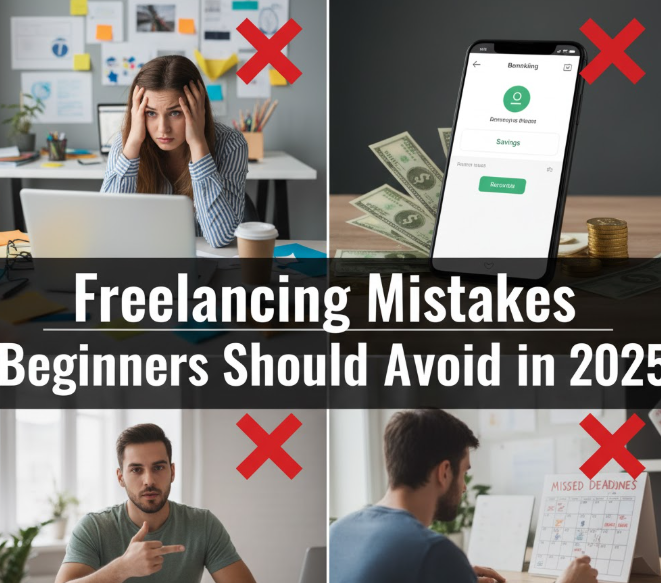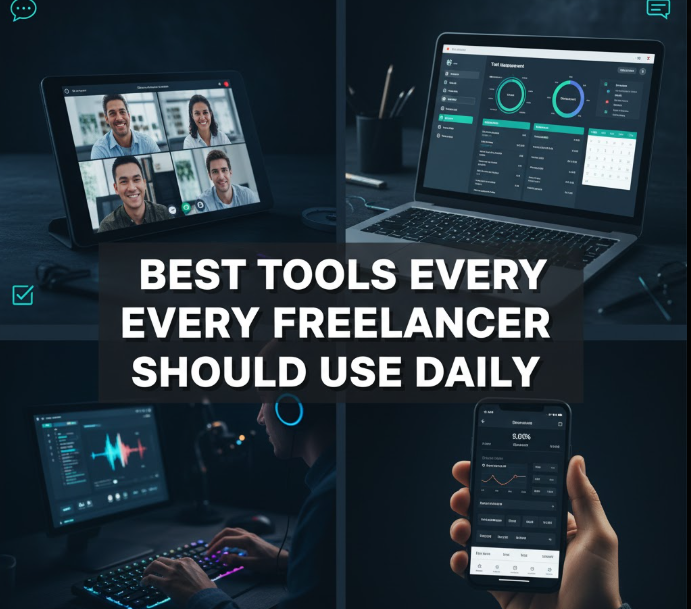Freelancing is the dream. You get to wake up whenever you want, work in your pajamas and never have the hassles of a drab office. But here’s the reality no one will tell you: Around 50% of new freelancers give up within a year. Why? Because they’re stupid, in a sense, and that can be prevented.
If you’re considering venturing out on your freelance journey in the year 2025, you’ve come to the right place. The world of freelancing has changed quite a bit and if it seemed to get you ahead five years ago, it might hurt you today. This guide will take you through the worst mistakes beginners make and actually how to avoid them. If you’re a designer, writer, programmer or consultant—whatever your skill is—you’ll stay away from those months of frustration and thousands of dollars in lost income.
Let’s dive in and ensure that you are one of the freelancers who don’t fail.
Taking a Leap Without a Net
Imagine this: You hate your job so much you wake up one day on a Monday and quit. You declare to the universe that you are now a freelancer. Sounds brave, right? It’s one of the quickest ways to fail, in fact.
The majority of freelancers who make it don’t walk out on their day jobs right away. They create their freelance business on the side, first. This requires working evenings and weekends for several months while they build up a client base and income. It’s a little like learning to swim. Day one, you’re not jumping in the deep end. It begins in waist-deep water, the kind where you can still feel the bottom under your feet.
You know what’s a smart approach to this? Up and quit your job once you land those first three to five clients. When you’re earning at least 50 percent of your current pay from freelancing, then consider going full-time. This could take three to six months, but you’ll sleep a whole lot better at night with it under you.
Your savings matter too. Three to six months worth of living expenses is a figure many financial experts recommend before going full-time freelance. This emergency fund acts as a buffer so you can still pay your rent, buy food, pay for insurance and take care of other payments if clients take their sweet time paying or work slows up for a bit.
Pricing That Doesn’t Make Sense for Your Business
New freelancers tend to make one of two pricing mistakes: charging too little, or not having a set structure for pricing at all.
When you charge far too little, you will attract the wrong clients. These are the ones who gripe, micromanage and disrespect your time. Even if you work until AD 4314, it’s likely that you’ll remain unable to pay bills. There is also the matter of low prices making potential customers suspicious. They ask what’s wrong with your work if you’re billing so much less than everyone else.
On the other extreme, some newbies freak out and start throwing numbers around for each project randomly. One client pays a service $500, while another pays the same thing $200. It’s simply confusing and makes you seem unpolished.
How To Charge Fair Prices For Your Services
Begin with some research on what other freelancers in your niche are charging. Join freelancers’ groups on Facebook, search for freelancers’ platforms and competitor websites. You’ll start to see a range. If you are a beginner, aim for the middle to lower-middle part of that range, not the bottom.
Here’s a rough pricing table for standard freelance services in 2025:
| Service Category | Beginner Price Range | Intermediate Price Range | Expert Price Range |
|---|---|---|---|
| Logo Design | $300-$500 | $500-$1,500 | $1,500-$5,000+ |
| Article Writing (1000 words) | $50-$100 | $100-$300 | $300-$1,000+ |
| Website Development | $500-$2,000 | $2,000-$10,000 | $10,000-$50,000+ |
| Social Media Management (monthly) | $300-$800/mo. | $800-$2,000/mo. | $2,000-$5,000+/mo. |
Remember, these are starting points. Your exact location, experience and specialization can push those numbers up or down.
Another consideration is the distinction between hourly and project-based pricing. Hourly fees are helpful when a project’s parameters aren’t evident. Project-based pricing is preferable when you know what the client needs. Experienced freelancers prefer project-based pricing, because while they often become more efficient and thus work faster with experience—they are still paid more per hour without penalizing themselves.

Skipping Contracts and Agreements
You come across a client you think is nice and probably trustworthy. They guarantee that you’ll get paid once the job is completed. You shake hands (or trade friendly emails) and you’re off. Then disaster strikes. The client evaporates, refuses to pay or expects you to do free extra work that you never agreed to.
This is the plight of thousands upon thousands of freelancers every single week. The answer is the most simple one possible: always use a contract.
A contract need not be written by a high-priced lawyer in fancy legalese. Most projects are fine with a simple written contract. Your contract should include:
- What you will and won’t deliver (with as much detail on the deliverables as possible)
- When it’s due (and the deadline)
- How much the client will pay
- When the client will pay (pre, during, or after project)
- How many revisions are included
- What happens if somebody decides they don’t want the project anymore
- Who owns the work when you are finished
Most freelancers use contracts they find online, or buy them (for $20-$50) from other people. Honeybook, Bonsai and even Fiverr have contract templates that cater to freelancers themselves. Just remember to personalize the template for each client and project.
Even if the client is your best friend’s cousin or a former boss, use a contract. Business is business. Professional relationships remain stronger when everything is in writing and crystal clear.
Trying to Please Every Single Client
When you’re eager, fresh and starved for work, you say yes to everything. A client hopes you will redesign their website, write their copy, design their logo, handle all their social media and walk the dog? Sure, you can do all that!
This is a trap. When you try to be everywhere, you end up being nowhere. Clients hire specialists, not generalists. They want somebody who is amazing at one thing, not okay at 10 things.
Choose a niche and stick with it, at least for your first year. If you’re a writer, pick what kind of writing you’ll concentrate on. Are you composing blog posts for tech firms? Building email newsletters for e-commerce companies? Producing case studies for B2B businesses? The more niche you go, the simpler it is to market yourself and charge premium prices.
Consider it through the eyes of a client. Who would you hire—someone whose website says “I do all kinds of writing for all kinds of businesses” or someone who says, “I write conversion-focused product descriptions for online fashion retailers”? The second voice is a knowledgeable professional who gets your problems.
You can grow your service offerings later as you become established. But early on, depth beats variety every time.
Forgetting That Marketing Never Stops
You land a big client who gives you three months of reliable work. Awesome! You go all in, work hard and do a great job. Then the project ends. You scan the room for who you’re going to work with next, and they’re not there yet. You’re going to have to turn around and start selling yourself again, and that could take weeks or even months.
This feast-or-famine cycle is what destroys most freelance careers. You’re either too busy working to find new clients, or you’re desperately hunting for work and getting no income.
The pro freelancers promote themselves all the time, even when they’re busy. This doesn’t mean you need to spend 8 hours a day on marketing. It involves devoting about 30-60 minutes a day to doing things that get you new clients:
- Posting on LinkedIn or any other social channel where your clients are hanging out
- Reaching out to prospects with a personalized message
- Asking current clients for referrals
- Adding new work to your portfolio
- Writing guest posts or producing content to demonstrate your knowledge
- Networking (whether in person or online)
- Reaching out to former clients who may have services they need again
Put an alarm in your phone if you have to. Make marketing as automatic as brushing your teeth. Do it every single day, even when you’re so swamped with client work.
Ignoring the Financial Aspects of Your Business
Freelancing is not free. It’s about running a business. That involves taxes, expenses, invoices and cash flow. Many creative freelancers despise this part of the process, ignoring it like a bogeyman until tax season descends.
Here is what can happen if you slack on the business side: You forget to track your expenses and give more money to the tax man than you need. You don’t pursue those unpaid invoices and you lose money. You spend as much as you earn and are holding nothing back for when quarterly taxes are due. You can’t show your income when you are trying to rent an apartment or get a loan.
Simple Systems That Save You
You hardly need to spend a fortune on software or enroll in accounting school. You need basic systems:
For invoicing: Consider tools like Wave (free), FreshBooks or QuickBooks. These send professional invoices and keep tabs on what clients owe you. Automate payment reminders so that you don’t have to uncomfortably hound your clients for money.
For expenses: Save every receipt connected with your business. Your laptop, software subscriptions, website hosting service and coffee shop wifi are things that lower your taxable income. Track everything with an app like Expensify, or even a simple spreadsheet.
For taxes: Freelancers typically pay taxes quarterly in the US. Allocate 25-30% of all the money you take in to a separate savings account. When it is tax time, you will have the money set aside rather than panicking.
For contracts and payments: Always request money upfront, typically 25%-50% of the total project cost. This filters out customers who are not serious, and brings you working capital while you work on the project.
Here is a monthly money checklist that every freelancer should follow:
| Task | Frequency | Why It Matters |
|---|---|---|
| Send invoices | Immediately after milestone/completion | Get paid faster |
| Follow up on unpaid invoices | Weekly | Some clients need nudges |
| Track expenses | Daily/Weekly | Maximize tax deductions |
| Review profit/loss | Monthly | Know if your business is healthy |
| Set aside tax money | Every payment | Avoid panic during tax season |
| Update financial projections | Monthly | Plan for slow months |
Relying on a Single Platform to Build Your Reputation
You have this super polished profile on Upwork or Fiverr. Clients start hiring you. Money flows in. Life is good. Then the platform tweaks its algorithm, raises its fees or suspends your account for a rule you had no idea you were breaking. And then, all of a sudden, your source of income disappears overnight.
Depending on only one platform is like building a house on someone else’s land. They can kick you out whenever they want, and you have no say. Savvy freelancers spread out where they meet clients and build their reputations.
Yes, start with platforms like Upwork, Fiverr or Freelancer. They are wonderful for getting your first few clients when you don’t have any reputation. But don’t stop there. Build these additional assets:
Your website: This is your little slice of the internet that no one can take away from you. It doesn’t have to be fancy. A single-page site with services, portfolio and contact info does wonders.
-
🔒 Worried about scams? Read this safety guide 👉 How To Avoid Scams on Microjobs Marketplaces
Social media presence: Choose one or two platforms where your ideal clients hang out. For most business freelancers, that means LinkedIn. For creative freelancers, perhaps Instagram or TikTok is more your speed? Post about your work and expertise on a regular basis.
Email list: Collect the emails of interested prospects. Email remains the surest means of connecting with potential customers, since you own the list.
Referral network: Your best clients come from referrals. If you do a good job, ask your happy clients if they know of anyone else that could use your services.
The goal is to eventually have the majority of your customers come from direct, rather than platform, channels. You’d avoid paying the 10-20% in fees and you can control your business more.
Saying Yes When You Mean No
A client presents you with a project that’s not quite in your wheelhouse. Or they want you to get going right away when you’re already swamped. Or there’s something off about them in your initial conversations. But you need the money, so you say yes anyway.
This almost always ends badly. There are only three possible outcomes when you take on a project that doesn’t fit: either you deliver subpar work and damage your reputation, or stress yourself out trying to accomplish what is actually impossible, or you end up working with an absolute nightmare client and their continuous demands.
One of the most important skills in freelancing is learning to say no. Here are scenarios in which you should seriously consider turning down a job:
The project is out of your skill set: If there’s a part of the project that you’re going to have to learn from scratch, this isn’t good. Obviously, you’re going to be learning something on every project, but you absolutely shouldn’t be learning major fundamentals on a client’s dime.
The deadline is impossible: Client needs a four-week job in a week? Unless they’re paying an absurd rush fee (50-100% more), say no. Rushed projects lead to lower quality of work and burnout.
The client has red flags: They are relentless discounters. They bad-mouth their previous freelancer. They don’t respect your boundaries in conversation. These are symptoms that only get worse once you start working together, not better.
You’re packed to the gills: There’s temptation to take on one more project for a little extra cash. Overcommit and you’ll either burn out or rush your way through everything. Neither is good for your business.
The money is too little: If a project pays so little that you’d resent working on it, then don’t do it. Resentment is apparent in your work quality and attitude.
When you say no professionally, it frequently commands more respect than if you had agreed. You might say: “It’s really nice of you to consider me for this project. But my work schedule currently won’t permit that degree of focus. I’m more than happy to refer you to another freelancer who may be a better fit.” This will help you maintain a positive relationship and demonstrate that you are professional.
Forgetting to Build Real Relationships
Some newbies treat every client visit as a one-shot deal. Do your work, get paid and move on to the next client. This makes you hustle for new business continuously, which is exhausting and costly.
The savviest freelancers cultivate long-term relationships that generate repeat business and referrals. The math is pretty easy: It’s a lot easier and more cost-effective to get work from a client you already have than it is to find a new one. And customers you served in the past already have some faith in you, which makes proposal-writing and negotiating less arduous.
Here’s how to convert one-time clients into lasting relationships:
Overdeliver just a little: Work more than you have to, but not so much that it burns you out; there’s magic in an extra touch that makes clients remember you. Maybe you point out a problem they didn’t even realize that they had, or you deliver a day early, or you tack on some bonus thing that only took 15 minutes but makes it more valuable for them.
Communicate early and often: Don’t make clients have to ask for updates—be proactive. A brief note such as “Just wanted to keep you in the loop; the project is on schedule and I should have a first draft for you by Friday” lets clients know you’ve got things under control, and keeps them from feeling neglected or out of touch.
Check in after a project ends: Send a quick note a week or two after you’ve completed your work to see how things are going. Are they happy with it? What else do they need? This little gesture of kindness is an opportunity for future work.
Stay in touch, occasionally: Every few months make contact with former customers with something of value. Perhaps you came across an article that might interest them, or you have a suggestion for how they can improve something in their business. Avoid asking for work in these messages; instead, provide actual help.
Request feedback and testimonials: After you have had successful projects with clients, ask if they would write up a testimonial to share. Most are happy to do so, and these endorsements serve as potent marketing devices.
One veteran freelancer told me that 80% of his income derives from just five long-term clients he’s been working with for years. He doesn’t have to pitch himself much anymore because these relationships keep him consistently employed and earning.
Disregarding Your Growth and Skills
The freelance world moves fast. Tools change, trends shift and client expectations transform. If you’re doing exactly what you did in the same way two years ago, you are falling behind.
The good freelancers spend time learning and polishing up their skills. By this, I don’t mean returning to school for a degree. It’s about staying current with your industry, and constantly becoming better at what you do.
Dedicate blocks of time each week for professional development:
- Enroll in online courses on sites like Udemy, Coursera or Skillshare
- Read industry blogs and newsletters
- Watch tutorials on YouTube from leaders in your industry
- Try new tools and methods
- Attend webinars or virtual conferences
- Participate in communities where other freelancers learn together
You’ll be able to charge more and get better clients as you get better. A freelancer who has been coasting for five years will start to lose clients to someone who has been on an incline for just two years. That’s how quickly things move these days.
And do not forget soft skills, in addition to hard ones. Learning to communicate better, manage your time really well, have difficult conversations and understand basic business strategy will make as much difference as the core skills that underlie why people hire you.
Treating Your Portfolio as an Afterthought
Your portfolio is your storefront. It is often the first impression potential clients get when making that decision to hire you. But many novices haphazardly slap a portfolio together with bad examples, without context for the work.
A robust portfolio does not have to represent everything you’ve ever done. It should show off your best work as it pertains to the clients you want to start attracting. Every time, it’s quality over quantity. Five strong examples are better than 20 mediocre ones.
For each portfolio piece, include:
- The project goal: What problem were you trying to solve?
- Your approach: How did you go about solving or making progress on the problem?
- The results: What happened when the client used your work? Numbers are powerful here.
- Visuals: Show the work, not just descriptions of it.
If you are just starting out and don’t have client work yet, make your own sample projects. Design a logo for a make-believe firm. Start a blog within your niche. Create a website for a fake company. These showcase your skills just as much as paid work does.
Keep updating your portfolio and adding new projects as you complete them. Take out old work that no longer shows your current skill level. Your portfolio should always reflect the kind of work you want to have more of.
Working Without Backup Plans
Technology fails. Hard drives crash. Video calls cut out in the middle of important meetings. Your computer breaks right before a deadline. These aren’t “what if” scenarios—they’re “when it happens” scenarios.
Freelancers who are not ready for these eventualities panic, miss deadlines and lose clients. Smart freelancers have backup plans:
Backing up your data: Use an automated cloud backup service like Backblaze, Google Drive or Dropbox. You should save your work in at least two places—on your computer and the cloud. For your most critical work, back it up to a third location on an external drive.
Spare equipment: You don’t necessarily need two of everything, but ask yourself what you would do if your primary tool broke. If you are a video editor, what happens if your system crashes? Do you have access to a backup computer? Or perhaps you have a friend with equipment that you could borrow? Could you rent something quickly? Having a plan means you can fix the problem in hours, rather than days.
Internet backup: If you lose your internet at home, where can you work? Coffee shop? Library? Coworking space? Friend’s house? Know your options before you actually need them.
Health backup: Freelancers do not have sick leave. If you are too sick to work, you do not get paid. Having that emergency fund you built up earlier will help with this. Some freelancers also build plenty of buffer time into their schedules so that a sick day doesn’t wreck a deadline.
Client backup: Never allow yourself to rely on just one client for the bulk of your income. If one customer makes up over 50% of your income, it is time to start diversifying. Proper financial planning involves making sure you have other sources of income to rely on when that client goes away (and it will eventually go away).

Frequently Asked Questions
How long will it take me to start making decent money as a freelancer?
Most freelancers need between 6-12 months to build an income they can rely on. The first couple of months are dedicated to learning, making mistakes, and building your reputation. By month six, assuming you are consistent with your marketing efforts and provide quality work, you should have a few steady clients. And by month twelve, you should be earning as much as you did with your traditional job if not more. Some people get there faster; others take longer—it depends on your niche, skills and how much effort you put in.
Should I work with clients who offer payment in the form of exposure or portfolio pieces?
Almost never. “Work for exposure” almost never turns into paying clients. The only exception is if you are just starting out and need to create sample work for your portfolio—even then, be very choosy about which projects you take. Once you have 2-3 projects in your portfolio, demand to be paid. People who respect your skills will be more than willing to pay for them.
How do I get my first freelance client?
Start with your existing network. Let friends, family, former colleagues, and social media contacts know that you are freelancing. Some of them will have work for you, and others will know somebody who does. Join freelance platforms such as Upwork or Fiverr to get some initial exposure. Reach out directly to small businesses that are most likely in need of your services. Offer them a special introductory rate to get some initial clients in exchange for testimonials and referrals.
What should I do if my client refuses to pay?
First, send a friendly reminder—sometimes people genuinely forget. If that doesn’t work, send a formal letter in which you state that they have 7-14 days to pay the bill; otherwise, you will take further action. For small sums, you may need to take the loss as a lesson to be more cautious next time. For bigger amounts, consider taking the client to small claims court. To avoid this situation: always work under contract, get paid in advance for at least a portion of the cost, and trust your instincts if a client seems like a poor fit.
How many hours should I work as a freelancer?
This varies wildly. Some freelancers work only 20 hours a week and make excellent money because they charge premium prices. Fifty to sixty hours are not uncommon while building the business for others. A reasonable goal is 30-40 billable hours per week, and add also 5-10 hours each week for business tasks like marketing, invoices and admin work. Keep in mind, too, that freelancing has unbillable work embedded into the process that salaried workers don’t need to think about.
Do I have to register a business and get licenses?
This depends on your location. In most places, you can freelance as a sole proprietor without any official registration. Once you start making significant income, you may want to consider setting up an LLC for legal protection purposes. Find out what is required for business licenses, permits and tax registration in your area. When in doubt, consult an accountant or small business lawyer; the expense will be worth it.
Should I focus on one service or offer many services?
Specialize, at least when you’re getting started. Focus on one service in your first year or two of business. It is easier to market yourself, charge more and become an expert at one thing. You can expand your offerings once you are established and profitable. As they say, “the riches are in the niches.”
Your Freelance Future Starts Now
Freelancing can lead to amazing things in 2025. More companies than ever are hiring freelancers, remote work is commonplace and technology has made it easy for people to collaborate with clients anywhere in the world. But success takes more than just knowing how to do your craft. You have to approach your freelance career as the business it is.
The errors we discussed in this guide have crushed countless freelance careers. The good news? Every single one of them is entirely preventable. You’ve been enlightened about the pitfalls before you fall into them. You know that freelancing is about balancing fantastic work, smart marketing, professional systems and constantly learning and growing.
Start small and build steadily. Don’t quit your job just yet unless you’ve prepared accordingly. Focus on only one service for your perfect client type. Use contracts always, no exceptions. Set aside money for taxes. Never stop marketing yourself, even when you’re busy. Say no to wrong-fit clients. Build relationships, not just transactions. Keep learning and improving. Have good backups of anything that’s important.
Will you still make mistakes? Absolutely. That’s part of learning. But you will avoid the huge mistakes which make people quit freelancing altogether. You will create a sustainable business with a lifestyle that works for the long run.
Freelance success isn’t about being the most talented or even the luckiest. It’s about the people who treat freelancing as a business, learn from failures and persist through difficult times. They’re the ones who make smart choices about pricing, clients and business systems.
You can be one of them. Take what you have learned here and put it into action. Your freelance future awaits, and now you’re ready to conquer it. Begin today, begin smart, and watch your freelance business develop into something you can be truly proud of.
For more resources on building a successful freelance career, check out Freelancers Union for additional support and community.




